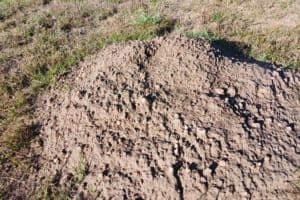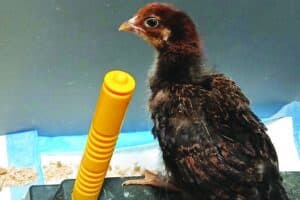Longtime local journalist Bill Radford and his wife, Margaret, live on 5 acres in the Falcon area with chickens, rabbits, dogs, cats, two noisy parrots, goats and two horses. Contact Bill at billradford3@gmail.com.
It was a Friday morning and Gary Glover was checking on the cattle on his Calhan property, just like any other morning. But there was something new in the pasture: a young hawk, standing next to an apparent litter mate that was dead.Glover decided to let the little hawk alone, hoping its mother would come to rescue it. But the next day, the hawk was in the same spot, with no sign of mom or dad. So Glover enlisted the help of Carrie Guy ñ- who’s both his daughter and his next-door neighbor ñ- and they brought the baby hawk some cooked chicken to eat and a bowl of water to drink from. They also removed the dead companion, thinking perhaps the surviving hawk was in mourning and would fly away.But it showed no interest in leaving. So Guy called a friend and co-worker ñ- Margaret, my wife ñ- to see if she could suggest a bird rescue. Margaret, in turn, called a friend who works at Colorado Parks and Wildlife. And that led to Corey Adler, a wildlife district manager with CPW, driving out to Calhan to check out the situation.With springtime ñ- and thus baby season ñ- underway, Adler expects more calls like this. Often, people will find hawks, owls and other baby birds on the ground and worry they’ve been abandoned. “A lot of times they’re not,” Adler said. “They just need to be put back in the tree or something like that.”One thing he looks at in deciding whether intervention is needed is if the baby bird is in an unusual spot; in this case, the young hawk was on the ground amid cattle ñ- “not anywhere it should have been,” Adler said. Add the fact that another baby was found dead next to it, with no sign of the parents, and it was clear this little hawk needed help.That’s not always the case with a young bird on the ground, he said. Sometimes it may have gotten too full when dining on some prey on the ground and isn’t ready to fly away; other times, the parents may be nearby and ready to help. If you try to come to the rescue, you could find yourself being dive-bombed by the agitated parents.That’s why people should feel free to call the experts at CPW, Adler said. “It doesn’t hurt to give a ring so we can assess the situation and see if it is worth us going out there and checking it out.” (The phone number for the Colorado Springs office is 227-5200; if outside of business hours, Adler said people can call the State Patrol, which will contact the on-call wildlife officer.)Adler suggests calling CPW over finding a wildlife rehabilitator on your own. Those people typically prefer to deal with the state agency rather than the public, he said. “Especially right now with this whole COVID-19 craziness, a lot of them won’t take anything from the public, but they will still deal with us.”Adler identified the fledgling in Calhan as a red-tailed hawk. He sent out an alert to the agency’s transportation volunteers and two women who were out in the field doing raptor surveys responded; they took the young hawk to the raptor center that’s part of the Nature & Wildlife Discovery Center in Pueblo (https://hikeandlearn.org/).”Most raptors, hawks and owls and such, they need to go all the way down to Pueblo to the raptor center there,” Adler said. The center rehabilitates about 200 raptors a year, according to its website. The Ellicott Wildlife Rehabilitation Center used to be another option, but it closed a few years ago.I visited the raptor center years ago for, ironically enough, a presentation on red-tailed hawks. The trip was research for our son, who was doing a paper on the hawks. Since I don’t have access to that paper, I looked online for a few nuggets of information. According to allaboutbirds.org:
- The red-tailed hawk is probably the most common hawk in North America. They’re often seen soaring above open fields.
- The red-tailed hawk has a raspy scream that has long caught the imagination of Hollywood. “Whenever a hawk or eagle appears onscreen, no matter what species, the shrill cry on the soundtrack is almost always a red-tailed hawk.”
- The oldest known wild red-tailed hawk was at least 30 years, 8 months old when it was found in Michigan in 2011, the same state where it had been banded in 1981.





